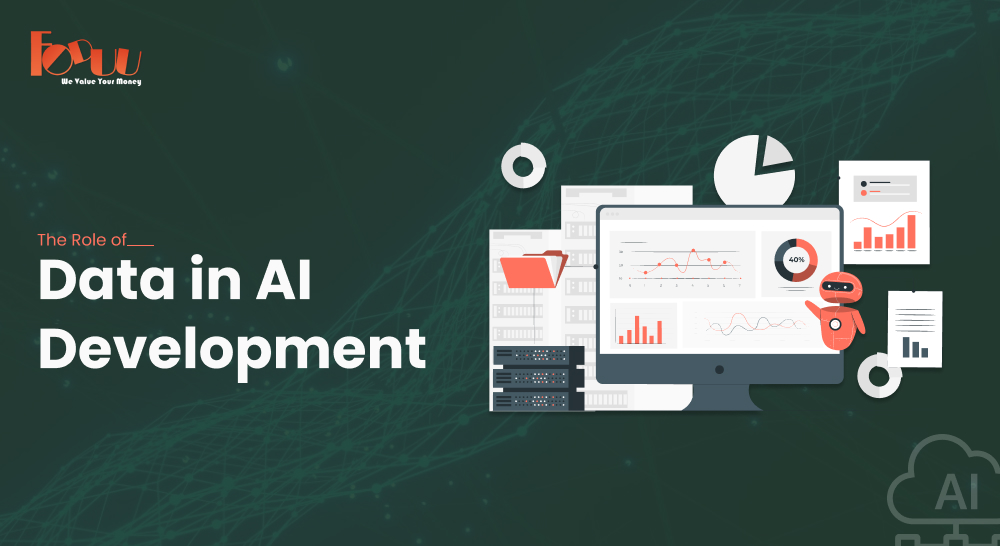Businesses across industries use Artificial Intelligence to automate processes as well as develop better decision-making tools and deliver better user experiences. AI technology changes both professional business procedures and home usage in multiple fields including healthcare finance manufacturing and entertainment. The success of artificial intelligence depends on data since these models use it to learn and develop smart forecast abilities.
Information supports AI development services through testing artificial intelligence systems that better process data and make more precise outcomes. Quality data in its proper design helps AI models work more effectively across different situations and produces useful results. AI systems that receive flawed data will create wrong insights while also threatening personal privacy and system security.
This content includes the role of data in AI development and looks at unique data types plus the development model alongside present-day issues and AI data development ethics and trends.
The Importance of Data in AI Development
1. Foundation for Machine Learning
Machine learning and deep learning systems need large amounts of data to find patterns develop from past examples and create data-based results. ML models use data exposure to build their predictive capabilities instead of sticking to set logical rules like rule-based systems do.
For instance:
Computer vision systems need labeled medical images to detect objects in images while finding both natural and health issues in scans.
An NLP system needs many text samples to locate emotional cues and spot spam with reliable language conversions.
Self-driving vehicles need constant sensor information flow to decide and operate safely with better performance.
A better AI system performance requires data that includes many different situations and types.
2. Increasing AI Accuracy and Performance
AI applications need to have high levels of accuracy to be effective. Data quality, volume, and variety have a direct influence on the accuracy of AI predictions.
For instance:
In detecting fraud, AI systems review financial transactions and user actions to detect abnormalities, needing to access billions of transaction records.
In healthcare, AI diagnoses use high-resolution medical images and patient histories to identify diseases like cancer at the early stages.
In chatbots and virtual assistants, AI training using multilingual text data facilitates improved conversation flow and context understanding.
As AI development companies strive to build more sophisticated AI models, they increasingly rely on diverse and high-quality data to deliver more accurate, real-world applications.
3. Facilitating Personalization and Predictive Analytics
AI-powered personalization improves user experience across devices. Through past interactions and behaviors analysis, AI personalizes recommendations and anticipates user needs.
E-commerce websites (Amazon, Flipkart) recommend products based on search history and buying behavior.
Video streaming services (Netflix, Spotify, YouTube) provide personalized content suggestions.
Virtual assistants (Alexa, Google Assistant, Siri) predict user actions and automate routine tasks.
4. Business Decision-Making Optimization
Businesses use AI-derived insights to enhance productivity, streamline operations, and achieve a competitive edge. AI algorithms analyze large data sets in real-time, revealing patterns and trends that may go unnoticed by humans.
Finance: AI determines stock market patterns, executes automated trading strategies, and identifies fraud in finance.
Retail: AI predicts demand, streamlines supply chains, and improves customer care through chatbots.
Manufacturing: AI identifies equipment failures and automates quality control procedures.
Related Post: Business Benefits of Artificial Intelligence (AI)
Types of Data Used in AI Development
1. Structured Data
Structured data is neat and tidy and stored in databases, which facilitates easy processing and analysis. Some examples are:
Customer information (names, addresses, purchases)
Sales transactions and financial reports
Patient health records (blood pressure, test results, prescriptions)
2. Unstructured Data
Unstructured data does not have a pre-defined format and needs special techniques for AI processing. Examples are:
Text data (emails, customer reviews, social media posts)
Audio and speech data (voice assistants, call center recordings)
Image and video data (security footage, medical scans, self-driving car footage)
3. Semi-Structured Data
Semi-structured data has elements of both structured and unstructured data. Examples are:
JSON, XML, and YAML data employed in web development
IoT sensor data with time stamps
Emails with structured metadata (subject, sender) but unstructured text body
4. Real-Time Data
Real-time data flow constantly from different sources, allowing AI systems to respond in real time. Some examples include:
Stock market price fluctuations
Sensor data from autonomous vehicles
Social media trends and user activity
Related Post: Freelance App Developer Vs App Development Company
The AI Development Pipeline and Data's Role
1. Data Collection
AI development begins with the collection of raw data from different sources, which may include:
APIs and web scraping
IoT devices and sensors
Open-source datasets (ImageNet, Kaggle, Wikipedia dumps)
Proprietary enterprise databases
2. Data Preprocessing
Raw data is frequently noisy, has missing values, or inconsistencies. Preprocessing activities involve:
Cleaning: Duplicates removal, error correction, dealing with missing values.
Normalization: Scaling numerical data to a fixed range.
Labeling: Annotating images, speech, and text for supervised learning.
Feature Engineering: Extracting significant attributes to improve model performance.
3. Data Storage and Management
AI systems need effective data storage solutions
Relational Databases (SQL, PostgreSQL) for structured data
NoSQL Databases (MongoDB, Cassandra) for semi-structured and unstructured data
Data Lakes (Amazon S3, Azure Blob Storage) for big data analytics
4. Model Training and Testing
Model training divides data into:
Training Data: The model learns patterns from this dataset.
Validation Data: Used to fine-tune model hyperparameters.
Test Data: Tests the model's generalization ability before deployment.
5. Model Deployment and Continuous Learning
Once put into production, AI models must be continuously watched and updated in order to evolve with new data.
Active Learning: Retraining models based on new data to improve performance.
A/B Testing: Comparison of various models to decide which one works the best.
Drift Detection: Detection of deterioration in performance caused by changing patterns in the data.
Data Issues in AI Development
1. Data Quality and Bias Issues
Missing, incomplete, or duplicate data may produce wrong predictions.
Bias in the training datasets might lead to unfair AI decisions.
2. Privacy and Security Issues
Adherence to GDPR, CCPA, and other laws is essential.
Encryption and anonymization methods are required for sensitive information.
3. Scalability and Storage Constraints
Handling petabytes of data demands scalable infrastructure.
Cloud computing platforms maximize cost-efficient AI training.
Ethical and Regulatory Aspects in AI Data Utilization
Fairness & Bias Reduction: Making AI unbiased using diverse data.
Data Transparency & Explainability: Rendering AI decisions understandable.
User Consent & Privacy: Safeguarding sensitive user information.
Future Trends in AI Data Usage
Synthetic Data Generation: Lowers reliance on actual-world data.
Federated Learning: Allows AI to be trained without centralizing raw data.
Self-Supervised Learning: AI learns from unlabelled data, reducing human labeling.
Blockchain for Data Security: Increases data integrity and confidentiality.
AI-Driven Data Labeling: Automatically annotates data for quicker model training.
Conclusion
Data is the lifeblood of AI development, driving its accuracy, scalability, and ethical impact. As AI continues to evolve, addressing challenges related to data privacy, bias, and security will be essential for responsible AI deployment. Organizations must prioritize data governance and continuous model improvement to unlock AI’s full potential across industries.
FODUU is a top AI development company in India, offering cutting-edge AI development services to clients worldwide. Contact us for a free consultation.
Related Post: How to Choose the Best Machine Learning Development Company




